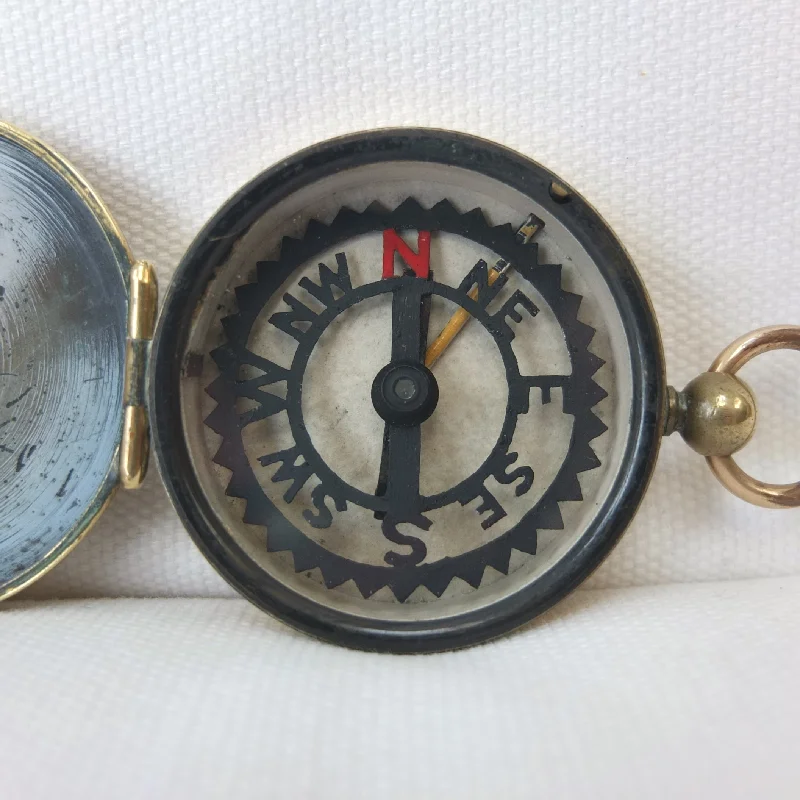A rare military 'Skeleton Dial' Night Marching pocket compass dating from 1900, made by Francis Barker for Negretti & Zambra. This Barker design was first sold around 1852. It has the retailers details, ‘Negretti & Zambra, London’, engraved on the base. This compass was presented to an Imperial Yeomanry soldier on his way to South Africa during the Second Boer War in January 1900. It has the following dedication engraved on the lid: 'Trooper E. O. Robotham. I.Y., Jan 10th 1900, With the best wishes of his old friends at 3 St Paul's'.
By the 1890's this type of compass design was being superseded by more modern designs, like the early service pattern compasses of the Verner type, and this compass was probably one of the last of this type to be made. Although this compass was retailed by Negretti & Zambra, it was undoubtedly made by Barker. Most of Barker’s products were supplied unsigned to the retail trade. Occasionally, they would have had the retailers name added when the compass was made, but most retailers simply added their own details to the case or dial before displaying it in their shop.
The compass features a 'skeleton’ type, cut-out aluminium dial and a white painted bowl to aid visibility at night. It would have been painted with a luminous compound (most probably ‘Balmain’s Luminous Paint’, patented in 1877), which was activated by exposure to very bright light, often created by burning a strip of magnesium ribbon. The instructions for rendering the compass luminous in this way would originally have been on a paper label inside the lid. This design was often described as a ‘Night Marching compass’ in catalogues of the period. The intricate dial design was one of Francis Barker's earliest, first produced in the 1850’s, and it can certainly be attributed to Barker as this design was only ever made by them. The compass has a jewelled pivot, a brass hunter case, and a transit lock operated by a lever on the top edge of the case. The case would originally have had a ‘bronzed’ finish, and this can still be seen on the interior of the lid.
Trooper Ernest Oliver Robotham (1877-?) was born in London and grew up in Berkshire, where his father, Oliver Robotham (1848-1914), was the Deputy Chief Constable of Berkshire. Ernest attended the Abbey School in Abingdon. He joined the Imperial Yeomanry in January 1900 (service no. 6098) and served with the 39th (Berkshire) Company, 10th Battalion, during the Second Boer War. His unit was formed from members of the Berkshire Yeomanry, and they went out to South Africa in February 1900. He was awarded the Queens' South Africa Medal in 1902. It seems that he remained in South Africa after the war, as he is listed in the 'Next of Kin' section of his brother Sidney's WW1 service records as being resident in Johannesburg in 1916.
Imperial Yeomanry: Following a series of defeats in South Africa during 'Black Week' in early December 1899, the British government realised that it would need more troops to fight the Second Boer War. There was a particular shortage of mounted troops. The War Office decided to allow volunteer forces to serve in the field alongside the regular army, and a Royal Warrant was issued on 24 December that officially created the Imperial Yeomanry. This was organised as service companies of 121 officers and men enlisted for one year. Existing Yeomanry members and fresh volunteers joined the new force, which was equipped to operate as mounted infantry. The companies were organised into battalions, often of companies from the same region - two companies of the 10th Battalion originated from the Berkshire Yeomanry. Besides the companies raised directly by the Yeomanry Cavalry regiments, a number of companies and battalions were formed by enthusiasts. These included Paget's Horse, the Sharpshooters and the Roughriders, all recruited in London. At the end of their year of service, recruits from a second contingent replaced the time-expired men in the original units and also formed new units. A third contingent was recruited from late 1901 onwards, largely as new units, while the existing battalions were consolidated.
Negretti & Zambra: were highly successful scientific and optical Instrument makers throughout the Victorian and Edwardian eras. Henry Negretti (1818-1879) and Joseph Zambra (1822-1897) formed their partnership in 1850. The company produced scientific and optical instruments and also had a photographic studio based in London. They were appointed opticians and scientific instrument makers to Her Majesty Queen Victoria, Prince Albert, King Edward VII, the Royal Observatory and the British Admiralty. Henry Negretti was the first man to take aerial photographs of London from a balloon. Throughout World War One Negretti and Zambra produced instruments for the Ministry of Munitions and developed many instruments for the Air Ministry.
Condition:
In very good condition and finds north well. The transit lock is in working order. The compass card and glass are in very good condition. The brass case is in good condition, with a few marks and signs of age and wear. It has the following dedication engraved on the lid: 'Trooper E. O. Robotham. I.Y., Jan 10th 1900, With the best wishes of his old friends at 3 St Paul's'.
Dimensions: 50mm diameter (80mm inc. bow & loop)
Further details of this type of compass can be found in Paul Crespel's excellent book, Trade Mark London, (p.100), which can be viewed as a PDF at the trademarklondon.com website.

